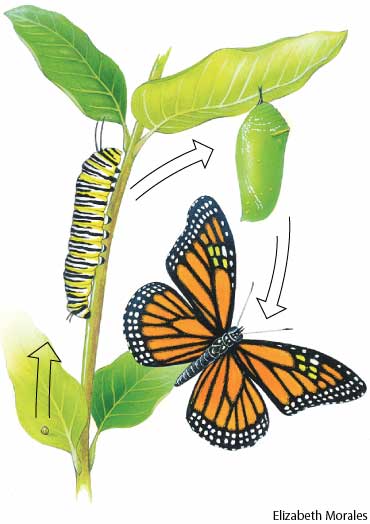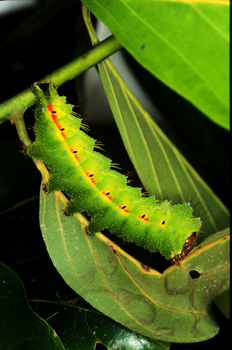![]()
When working with caterpillars it is important to understand their lifecycle. A caterpillar is a wormlike and often brightly colored or hairy or spiny larva of a butterfly or moth. It is nearly impossible to tell whether a caterpillar will turn into a moth or a butterfly without identifying the species of caterpillar. Dr. Dyer has been working for over 15 years collecting caterpillars and rearing them to determine what they look like as an adult. To view this work you can go to www.caterpillars.org .
Butterflies and moths as well as some other insects and frogs, go through metamorphosis. According to the Encyclopedia Britannica metamorphosis is, "In biology, any striking development change of an animal's form or structure, accompanied by physiological, biochemical, and behavioral changes."
Complete metamorphosis of butterflies and moths involves four (4) stages: the egg, the larva (caterpillar), the pupa (chrysalis or cocoon) and the adult. In the caterpillar stage the caterpillar grows rapidly. Unlike humans the caterpillar has its skeleton on the outside, this is known as an exoskeleton. When the exoskeleton is too small the caterpillar sheds or molts its exoskeleton. Most caterpillars do this five times. This molting is known as an instar. Growth can be measured during each instar It is also a way to describe a caterpillars development. For example during my lab work at Tulane I had to weigh twenty (20) different caterpillars at each instar. That means that I weighed 100 different caterpillars. In the fifth instar, one of the spodoptera exigua weighed 254.1 milligrams. One of the caterpillars I weighed in the 1st instar weighed 1.2 milligrams.
Below is the life cycle of the Beet army worm, which in adult form is a moth, that is commonly used in research work. This caterpillar is a generalist, meaning it will eat almost anything making them easy to rear.

![]()
Butterflies go through a metamorphosis too, below is an illustration of the life cycle of a Monarch Butterfly.

http://www.thefreedictionary.com/metamorphosis
Caterpillars fall into two groups generalists and specialists. Generalists will eat anything, they are not picky. However, specialists only eat one particular plant. Here in the lab at Tulane, Angela Smilanich a graduate student, is working with Buckeye Butterflies, they are generalists. They eat plants from the snapdragon family (Antirrhinum) and toadflax (Linaria); the plantain family including plantains (Plantago) and the acanthus family including ruellia (ruellia nodiflora). The female buckeye lays her eggs one at a time on the leaf buds or on the upperside of the host plant. The monarch butterfly is a specialist it only eats milkthistle. Another example of a specialist is Copaxa curvilinea from the family Saturniidae. It only eats the plant Nectandra membranacea. In La Selva, Costa Rica; Yanayaca, Ecuador; and Arizona Dr. Dyer is collecting and cataloging caterpillars. In many cases this is the first time that the caterpillar has been identified. In order to identify the adult many of the caterpillars are collected and raised in field laboratories. The work has been in progress for about 15 years and you can view the work at www.caterpillars.org.
Example of a Generalist: Buckeye Butterfly

Source of picture: http://www.ivyhall.district96.k12.il.us/4th/kkhp/1insects/buckeye.html
 Snapdragons one of
the food sources for the buckeye
Snapdragons one of
the food sources for the buckeye
http://www.scienceu.com/library/articles/flowers/images/small/snapdragon.jpg
Example of a specialist:
 Copaxa
curvilinea,with its host plant Netandra membranaceafrom La Selva,
Costa Rica
Copaxa
curvilinea,with its host plant Netandra membranaceafrom La Selva,
Costa Rica
Dyer, L.A. and G.L. Gentry. 2002. Caterpillars and parasitoids of a tropical lowland wet forest. http://www.caterpillars.org. Accessed: (June 29, 2005).